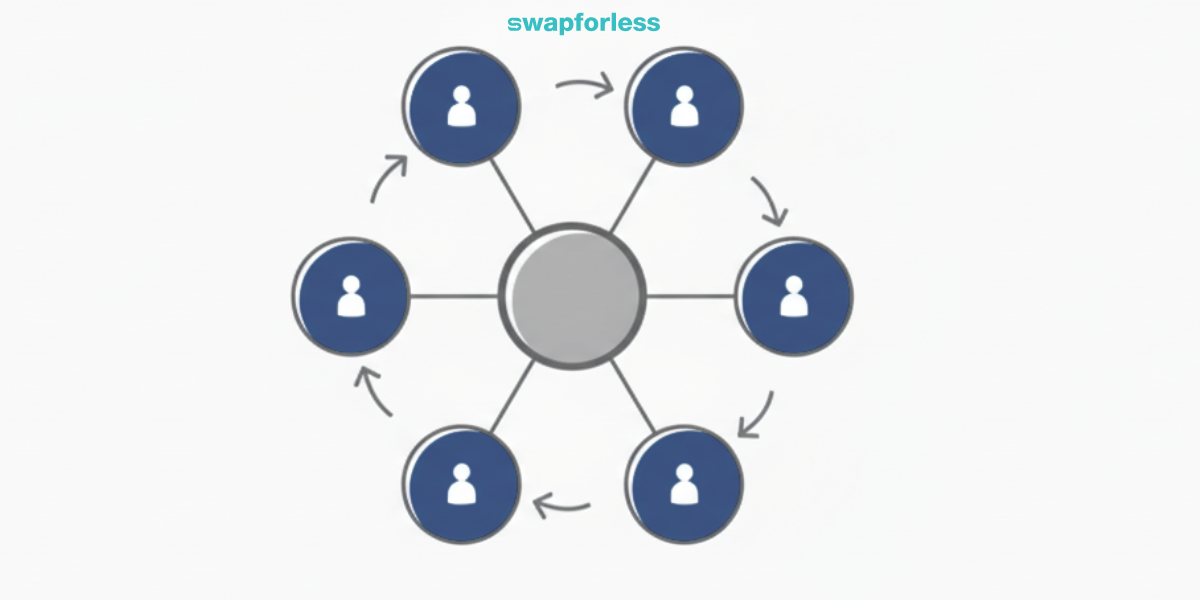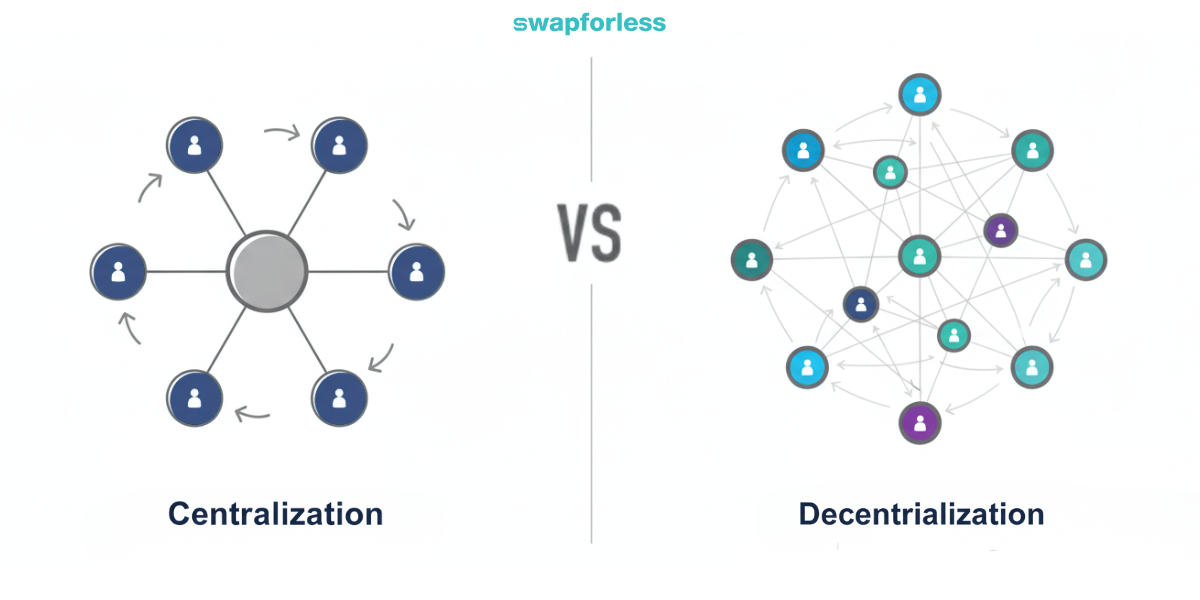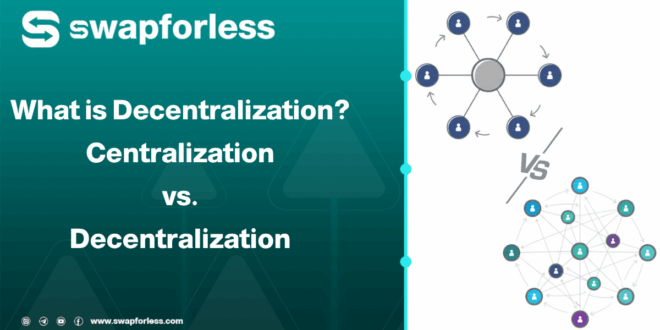You’ve likely heard the word “decentralization” everywhere these days, especially when discussing crypto and blockchain technology.
So, what is decentralization? And more importantly, how does it differ from the centralization we’re used to in our daily lives?
This guide will simply explain Centralization vs Decentralization and how this fundamental principle paves the way for future technologies like blockchain.
Let’s Start with Its Opposite: What Are Centralized Systems?

Centralized systems are the model we live in and interact with every day. Simply put, a centralized system is one that is completely controlled from a single point or authority.
All decisions, power, and data are held and controlled in one place.
Take your bank as an example:
- The bank is a central, trusted intermediary that holds all your money and transaction records.
- If the bank wants to close your account or freeze your funds, it can do so with a single decision.
- If the bank’s main server goes down, all services (like the banking app or ATMs) stop working.
- You are forced to place your complete trust in this intermediary (the bank) to protect your money and manage your transactions honestly.
This principle also applies to governments and large corporations like Meta (Facebook) that control all your data on their servers and most applications we use daily.
What is Decentralization?

Decentralization is the idea of distributing power, control, and data among many participants (devices or people) instead of concentrating it at a single point.
Let’s return to the bank analogy: Imagine a financial system with no central bank. Instead, every person participating in this network owns an identical and complete copy of the ledger.
- When a new transaction occurs (someone sends money to another), it is broadcast to everyone.
- A majority of the network must verify this transaction and approve it.
- Once it’s recorded in the ledger, no single person (neither the sender, receiver, nor even an “admin”) can delete or change it.
The result is a system with no single point of failure, no single entity that can impose censorship, and where trust is transferred from the intermediary to the network itself.
Centralization vs Decentralization

To clearly understand the difference between centralization and decentralization, here is a direct comparison of how the two systems operate:
| Feature | Centralized System | Decentralized System |
| Control & Authority | In the hands of one entity (company, bank, government). | Distributed among all network participants. |
| Point of Failure | If the main server is breached, the whole system collapses. | To breach the network, thousands of devices must be compromised. |
| Trust | You are forced to trust the intermediary (to be honest and not make mistakes). | Trust is built into the code and the network’s rules. |
| Transparency | Operations are internal and opaque (you don’t see the bank’s internal logs). | High transparency (everyone can verify the recorded transactions). |
| Censorship | Easy; the controlling entity can block you or stop a transaction. | Very difficult; the system is designed to be censorship-resistant. |
How Does Decentralization Relate to Blockchain and Crypto?

Decentralization in blockchain is the secret ingredient that gives this technology its power; it is the foundation the entire technology is built on.
- The blockchain technology we explained earlier is, at its core, a practical application of the idea of decentralization. Blockchain is a distributed ledger that allows data to be recorded in a secure and distributed way.
- This principle is completely changing how financial applications work and has led to the birth of an entire sector known as Decentralized Finance (DeFi), which is an alternative financial system that operates without intermediaries.
- So, instead of centralized platforms (like banks or traditional cryptocurrency exchanges) that control your assets and funds, decentralized exchanges (DEXs) have emerged, giving you complete control over your money. We have previously detailed the difference between CEX and DEX exchanges in a full article.
- To allow the majority of these decentralized platforms to operate automatically and without a human intermediary, they rely on code running on the blockchain called smart contracts. These contracts are what execute exchange orders (like buying and selling) automatically when the conditions are met. They form the foundation upon which DeFi projects operate.
What are the Main Benefits of Decentralization?

When this principle is applied correctly, it offers enormous benefits compared to traditional systems:
- Higher Security: With no central point of failure, decentralized systems are highly resistant to targeted hacks or technical outages.
- Censorship Resistance: No single entity can easily shut down the service, delete records, or block a specific user from participating.
- Transparency and Trust-Building: The rules (code) are often open and clear to everyone, and historical records cannot be changed, building trust based on verification rather than just reputation.
- User Empowerment: Decentralization gives you true control over your assets (like your money in a decentralized wallet) or your personal data, instead of handing it over to a large corporation.
Is Decentralization Perfect? Drawbacks and Challenges
Of course not; this model comes with its own set of challenges that we must be aware of:
- Speed (Scalability): Decentralized systems (like blockchain) are often slower than their centralized counterparts. This is because a transaction needs verification and approval from many participants (nodes) instead of a single decision from a central server.
- Energy Consumption: Some mechanisms for verifying transactions (especially “Proof-of-Work”) require immense computational power and consume huge amounts of electricity. However, more sustainable alternatives like “Proof-of-Stake” are being developed.
- Security Challenges: Although security is a strong point, blockchain is not completely invulnerable. There have been hacks targeting the “smart contracts” (the programs) that run on the networks, leading to financial losses. Securing these systems remains an ongoing challenge.
- Compatibility: There are currently many different blockchain networks that operate as isolated “islands,” meaning they cannot easily communicate or interact with each other. This lack of compatibility limits the seamless exchange of data and value between systems.
- Full Responsibility: This point is a double-edged sword. In a decentralized system, “you are your own bank.” If you lose your private keys or password to your wallet, there is no customer service you can call to reset it. Your funds could be lost forever.
- Complexity: Many decentralized applications are still complex to use compared to the simple centralized apps we are used to.
In Conclusion
We have seen the difference between centralization and decentralization and understood that this new model offers enormous benefits like security and user empowerment, but it also comes with real challenges like speed and full responsibility.
Understanding this fundamental principle is the real key to grasping the power of technologies like blockchain, smart contracts, and decentralized platforms that are shaping the digital future.
 swapforless blog
swapforless blog



